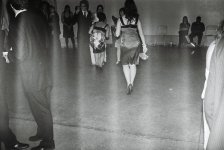Thanks everyone for their helpful suggestions. The answer doesn't seem a straightforward one, so perhaps some more detailed information is in order.
sleepyhead - Yes, the stripes line up exactly with the perforation holes.
KenD - Yes, all the frames show some striping, though some are more noticeable than others. Ditto milky-ness
And here's a tracing of my development steps:
Camera was M4-2, using Tri-X rated at 400. No problems with light leaks before.
1. Developer was fresh DDX 1+9 for 12.5 minutes, with 3 agitations after the first minute and 1 agitation every three minutes after
2. Stop bath for 30s
3. Fixer was Ilford diluted to 1+9. I agitated ~20 times for the first minute then a couple of times every minute for a total of 5 minutes. I had used the batch once the day before.
4. Wash (Ilford method)
5. Hypoclear 2mins
6. Wash (Ilford method)
7. Photoflo for 30s
8. Hang to dry
I just tested the same batch of fixer using a strip from a bulk spool. It cleared entirely in 5 mins.




